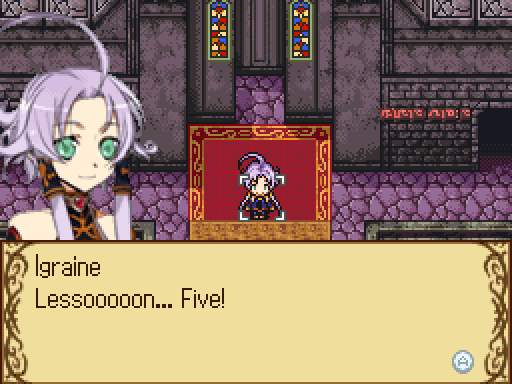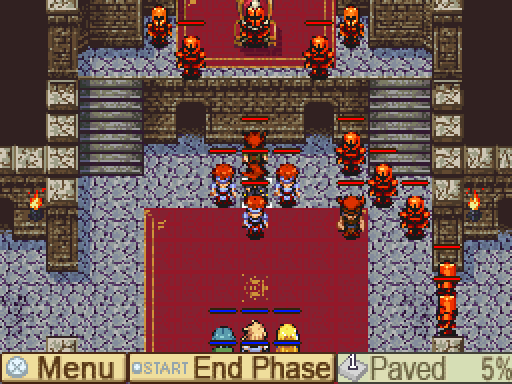
A masterclass in remasters: Star Ocean: The Second Story R.
January 29, 2024
We log off from The World in .hack//Quarantine.
February 20, 2024Chaotic, messy, and addictive: Rondo of Swords.
I mentioned in a previous review how the core ideas of a strategy RPG sound dull: you place a small army of soldiers that move a certain number of spaces on an isometric map and exchange blows until victory conditions are met or you suffer a defeat. Attacks are exchanged when two units are side by side. Sometimes they can attack from afar with ranged weapons. Sometimes they can attack from even further with magic. Etcetera, etcetera. Of course, anything will sound dull when you break it down to its most basic schematic. Amazing strategy RPGs like Final Fantasy Tactics, Stella Deus and Luminous Arc use these basics but have various gameplay elements that boost the experience. And then, we have Rondo of Swords. This is a game that defenestrates the idea of a strategy RPG six ways to Sunday. The result is something disorderly, yet addictive.
Taking place on the continent of Bravord, Rondo of Swords has a familiar start. It begins in the Kingdom of Bretwalde. The opposing Grand Meir Empire has overrun the Royal City of Egvard during the funeral services for the late King Elliott. As the troops attempt to rally and citizens attempt to find safety, Prince Serdic and two of his most trusted soldiers, Kay and Margus, decide the best course of action is to flee the kingdom and seek aid from an ally force. Clutching the Holy Blade Spanta, Serdic has a long, uncertain, and difficult journey ahead. He also has a secret that he’s keeping from his closest allies.

I felt for Serdic the moment the game began. We’re given a front row seat to his past and secrets. These amplified his burdens, and as a result, I wanted him to win. Naturally, Serdic wasn’t alone. Along with Kay and Margus, Serdic was joined by a surprisingly hefty group of soldiers that had their own reasons for wanting to assist the Kingdom of Bretwalde. Ansom was my favorite. He was an archer from the Shalem Federated Emirates that had a quick mind and an even quicker trigger finger. To my surprise, there were some secret cameo characters that joined Serdic’s squad. One, and possibly the most powerful unit in the game, was Cotton from the series of the same name. I had no familiarity with her or her “cute ’em up” games, but I appreciated her joining. There were other secret characters that fans of Nintendo DS RPGs, Atlus, and Success Corporation will gobble right up. I won’t say who because seeing them was a wonderful surprise. Yet, despite such a varied cast, character interactions were scarce. Dialogue between characters occurred more in battle than out, but activating these dialogues meant having the right characters next to each other on a specific map. It’s hard to deny that it was a missed opportunity.
From the very beginning, the game threw you right into the thick of it. The formula was story moment, troop preparation, combat, and repeat. Combat used a familiar player turn/enemy turn setup. The first map had Serdic, Kay, and Margus battling their way to an escape point while close to 20 enemy troops stand at the ready. If Serdic died, then the game ends. Serdic didn’t become the hero he could be until much later in the game. In Rondo of Swords, basic strategy was removed for the one-of-a-kind Route Maneuver System. Instead of moving a unit from one square to another and performing an attack, you set units on a drawn path where they attack everyone on their way and gain boosts from their allies en route to the end of it. So, if there’s a big ol’ honking line of enemies, and if your character has the MOV to do so, then he or she can move through each enemy, landing an attack. It’s something we’ve never seen before.

But, it’s something that we’ll never see again. It’s messy, it’s unrealistic, it’s frustrating, and yet it was somehow overly satisfying in the rare moments it worked. Naturally, enemies could do the same. Enemies were both strong and smart ALWAYS outnumbered your meager party of six, forcing trial and error. Seeing your squad fall to pieces in a matter of seconds was nothing out of the ordinary. Not even due to poor tactics. Magic’s reach was nuts, and moving just one square to fire will cause an onslaught of magicians to cast their worst on that unsuspecting unit. Magic users can only use their list of spells before a movement. To add to the chaos, archers are the only unit that can attack after a movement. Both archery and magic are immensely powerful; by the time I had units capable of both I made sure that they were in my party as often as possible. Note that there were multiple ways to reset a battle while retaining your experience points in case some power levelling becomes necessary.
I won’t get into things like Momentum Counters or Over Breaks. I will, however, talk about the Hurt status. If a unit falls in battle, they’ll be “Hurt” during the next map. This penalized all stats by at least half. It also prevented them from going on Errands. Outside of combat, units could be sent on various odd jobs to improve their stats or earn a class change. Shopping was included in this list of errands. Rondo of Swords was so outside the box that it doesn’t even approach shopping the traditional way. Instead, you pick a unit to go shopping, decide whether they’re buying or selling, and hope for the best. Would they come back with new stuff or would they lose all your money? It adds to the hot messiness that is Rondo of Swords.
Topping off this messy yet lovable cake is the presentation. The music was a letdown, with only a few tracks. But, there was some campy voice acting that fits into the game’s 2008 2D anime aesthetic. The sprites were fine. You can thankfully skip the attack animations. They got stale after a few watches. Otherwise, the perspective and map styles were probably the only thing relatively normal about the game.
Rondo of Swords was a challenging game for all the right and wrong reasons. However, my playtime was just a bit over 20 hours. Despite all the hurdles, I was able to finish it in a short amount of time. The funny thing is that I still want more. The game features multiple endings and pathways, and the chance to go through this tornado of a strategy game has an appeal. But, do I actually recommend it? It’s hard to say because it won’t appeal to fans of strategy RPGs, nor will it appeal to people looking into them for the first time. Rondo of Swords’ audience, like many of the battle maps, will be a crapshoot. I guess I’m one of the “lucky” ones.
Overall, 6.5/10: A sordid strategy game if there ever was one, Rondo of Sword ditches the conventional for the unique with mixed results.





